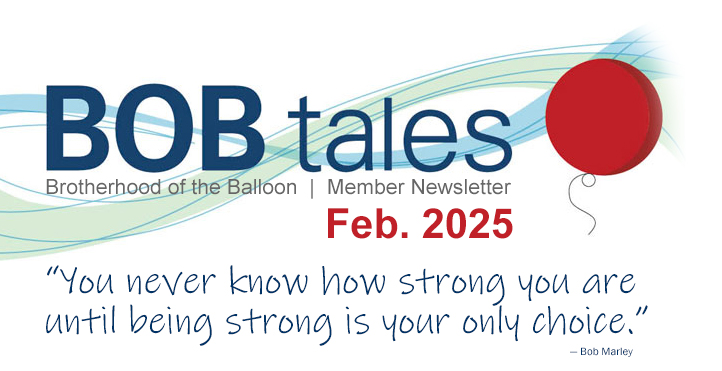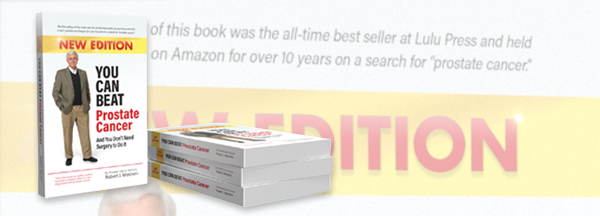

Dear Members (a note from Deb Hickey)
As February approaches, I find myself reflecting on the incredible strength and resilience of those I know who have faced a cancer diagnosis. February marks National Cancer Prevention Month, a time to honor the journeys of these individuals—including you, our valued members—and to remind ourselves of the power we hold in living healthy, vibrant lives moving forward.
Most of those reading this are survivors—testaments to the power of hope, determination, and the will to live. Your stories inspire others, and your courage is a reminder to all of us to never give up. While we often talk about the importance of diet, exercise, and other healthy life choices in the BOB Tales, we also know that there’s so much more to this journey than just physical health. The emotional, mental, and spiritual challenges of a cancer diagnosis and the road to recovery are profound, and it’s important that we take time to acknowledge those too.
This month, let us stand in solidarity, not only with those who are survivors, but also with those who are currently fighting. We know how difficult and uncertain the path can be, and our hearts go out to those still facing the struggle. May we continue to support one another—through prayer, encouragement, and acts of kindness—as we remember that the road to healing is often paved with love and community.
Let us also take this opportunity to pray for those still in the battle and for their families, who carry so much of the weight. It’s important to recognize that we’re never truly alone in this journey. Together, we form a circle of hope, one that grows ever stronger as we continue to fight for health and healing.
In the spirit of National Cancer Prevention Month, we encourage you to keep embracing a lifestyle that nurtures your well-being, to be proactive in your health, and to continue sharing your wisdom and strength with others. Your stories matter, and your lives are an incredible gift.
Thank you for being part of the BOB community. Your resilience and unwavering spirit give us all hope for the future.

In this issue of BOB Tales, we highlight new research that challenges the long-held belief that testosterone therapy increases the risk of a prostate cancer recurrence. Additionally, another study confirms that testosterone therapy is safe for heart health in older men, reassuring those hesitant due to cardiovascular risks. This month, we also discuss the tough decision between choosing treatment or active surveillance, featuring one man’s regret over opting for surgery. In other news, recent research shows that an omega-3 diet may help slow prostate cancer growth, while another suggests a genetic score could predict cancer progression. And finally, in our News section, we bring attention to a study linking firefighting to an increased risk of prostate cancer, highlighting the need for preventive health measures for those exposed to toxic chemicals in their line of work.
In our general Health section, we report on the Surgeon General’s recent and urgent advisory linking alcohol consumption to an increased risk of cancer. On a lighter note, thanks to a suggestion from BOB member Arlind Hackett of Highland, CA, we dive into the growing popularity of pickleball—a fun, heart-healthy activity that’s especially attractive to older adults. Arlind wrote in an email: Not only is pickleball a great exercise, it’s also FUN. I’ve read research that shows when people enjoy their exercise, it’s even more beneficial! We also offer injury prevention tips for staying active in sports like pickleball and golf, especially for seniors, because, as we all know, those injuries tend to creep up with age.
Finally, in our Member Spotlight section, Bob Marckini writes a heartfelt tribute about the passing of his dear friend, BOB member Chuck Kubicki—an extraordinary man who faced life with unmatched vigor, generosity, and a passion for giving back. Bob shares stories of Chuck’s energy, his courage in the face of prostate cancer, and the lasting impact he made on the BOB community and beyond.
As always, we welcome any suggestions you have on improving the value of the BOB Tales to our members. Please send your feedback to [email protected].
Deb Hickey

*Click here for the printable PDF version of this newsletter.
- Testosterone Therapy After Prostate Cancer: New Evidence Challenges Old Beliefs
- Testosterone Therapy Is Safe for Heart Health in Older Men
- Surgery vs. Active Surveillance – an Easy Decision?
- Omega-3 Diet with Fish Oil Slows Prostate Cancer Growth
- Genetic Risk Score Could Predict Prostate Cancer Progression
- Firefighters at Greater Risk for Prostate Cancer Due to Toxic Chemical Exposure
- Surgeon General Issues Urgent Advisory on Alcohol-Cancer Link
- Pickleball: Revolutionizing Health and Longevity
- Preventing Injuries in Pickleball, Golf, and Beyond
Testosterone Therapy After Prostate Cancer: New Evidence Challenges Old Beliefs
For decades, testosterone therapy was considered off-limits for men with prostate cancer due to concerns it could stimulate cancer growth. However, new research, led by Dr. Jose M. Flores at Memorial Sloan Kettering Cancer Center, is challenging these long-held beliefs. Despite this, the fear of exacerbating prostate cancer persists, dating back to the 1940s when Huggins and Hodges first linked androgens to cancer progression. As recently as 20 years ago, only a small minority of urologists would consider testosterone therapy for prostate cancer patients.
In contrast to this past approach, new studies suggest that testosterone therapy may not increase the risk of biochemical recurrence (BCR) for men with prostate cancer and undetectable PSA levels after radical prostatectomy. Dr. Flores’ study, which tracked 5,199 patients, found that both men who received testosterone therapy and those who did not had a 2% BCR rate after five years, regardless of cancer grade. This aligns with a growing belief that testosterone replacement can be safe for certain prostate cancer patients, particularly those who have undergone prostatectomy or are on active surveillance. However, close monitoring is still essential, especially for men with lower baseline testosterone levels, who may face a higher risk of PSA rise after treatment.
Dr. Flores’ study marks a significant shift in the management of prostate cancer patients, suggesting that testosterone replacement can be considered under careful guidance and monitoring. This evidence may encourage urologists to reconsider strict guidelines and expand the use of testosterone therapy for men with prostate cancer who are in remission, potentially revising the American Urological Association (AUA) recommendations.
Despite these promising findings, experts stress that testosterone therapy for prostate cancer patients should be individualized and monitored closely, particularly for those with high-risk or metastatic disease. Still, ongoing research and accumulating evidence are gradually softening the long-standing ban on testosterone replacement, offering these men a potential path to improved quality of life.
Testosterone Therapy Safe for Heart Health in Older Men
Building on the growing evidence supporting the safety of testosterone replacement therapy (TRT) in men with prostate cancer, a recent study from Cedars-Sinai expands the conversation to TRT’s impact on heart health. For years, concerns over cardiovascular risks, particularly heart attacks and strokes, had overshadowed discussions about TRT.
However, the study provides reassuring evidence that TRT does not increase the risk of heart attack or stroke in men aged 45 to 80 with low testosterone levels. This finding is particularly significant for those men who may benefit from TRT for low testosterone symptoms but have long been wary of the potential cardiovascular consequences.
While the study does indicate a slight increase in the risk of atrial fibrillation, it suggests that TRT, when carefully managed, may improve quality of life without posing significant heart health risks. Nevertheless, physicians continue to advise close monitoring, particularly for those with existing cardiovascular concerns, as the long-term safety of TRT remains an area of ongoing research.
Surgery vs. Active Surveillance—an Easy Decision?
A new program at Inspire.com, in partnership with ZERO Prostate Cancer, aims to improve the quality of life for prostate cancer patients and their families. The platform allows individuals to ask questions, share experiences, and receive advice on topics like prostate cancer awareness, screening, treatment, and side effects.

In a recent post, a 66-year-old man shared his deep regret over choosing robotic surgery for his Gleason 7 prostate cancer. He now struggles with severe incontinence and impotence. “The incontinence is terrible and very embarrassing,” he writes, “and I haven’t even dealt with impotence yet.” His caregivers tell him he may see improvement in both areas over time, especially if he practices certain exercises.
The man is encouraging readers who may be diagnosed with prostate cancer to avoid surgery and, instead choose active surveillance until their prostate cancer advances to more aggressive levels.
BOB Comment: We feel differently. While we agree that surgery may not be the best choice (note the title of Bob’s book), other treatment options like proton therapy and IMRT are just as effective at destroying cancer, yet are gentler on the patient—particularly when it comes to avoiding dreaded side effects like impotence and incontinence. Bob’s book includes several patient surveys supporting this perspective. As for active surveillance, we strongly support it when the patient’s age and cancer staging criteria are appropriate. However, it's important to always consult with your doctor before making this decision.

Omega-3 Diet with Fish Oil Slows Prostate Cancer Growth
A new study from UCLA Health Jonsson Comprehensive Cancer Center suggests that a diet low in omega-6 and high in omega-3 fatty acids, combined with fish oil supplements, may help slow prostate cancer growth in men undergoing active surveillance.
A year-long clinical trial involving 100 men with low-risk or favorable intermediate-risk prostate cancer showed that those on the modified diet—focused on reducing omega-6 intake from processed foods and increasing omega-3 intake through fish and fish oil supplements—had a 15% reduction in the Ki-67 index, a biomarker for cancer cell growth. In contrast, the control group saw a 24% increase in the same biomarker.
While these results are promising, more research is needed to confirm the findings and assess the long-term impact of dietary changes on prostate cancer progression. Larger trials will be essential in understanding how omega-3 and omega-6 modifications could influence prostate cancer outcomes and survival. This study provides important insights into how diet might play a role in managing prostate cancer, particularly for men on active surveillance.
Genetic Risk Score Could Predict Prostate Cancer Progression
A recent study suggests that a new genetic tool, called the polygenic risk score (PRS), may help doctors better identify men with prostate cancer on active surveillance (AS) who are at a higher risk of their cancer becoming more aggressive. The study, which followed 1,220 men with low-risk prostate cancer, found that men with a high PRS at the time of diagnosis were more likely to experience cancer progression, such as upgrading to a more aggressive grade or even developing multiple tumor sites.
The PRS, which analyzes 451 genetic variations linked to prostate cancer, was used to assess how likely men were to experience changes in their cancer. The results showed that men with a higher PRS had a significantly greater risk of cancer progression, with those having the highest score being twice as likely to experience upgrading, helping doctors predict who may need more aggressive treatment sooner.
While the PRS could help personalize monitoring, experts caution that it doesn’t significantly outperform traditional methods like PSA levels and biopsy results, and it’s not yet fully validated for widespread use.
Overall, while the study suggests the PRS could one day help identify patients who may benefit from more frequent checkups or interventions, more research is needed.
Firefighters at Greater Risk for Prostate Cancer Due to Toxic Chemical Exposure
A groundbreaking study reveals that firefighters may be at an increased risk for prostate cancer due to exposure to toxic chemicals encountered in their work. Co-authored by researchers from the University of Arizona and the University of Michigan, the study explores how long-term chemical exposure—specifically to firefighting foam and smoke—can trigger epigenetic changes that influence cancer risk. Unlike previous research, which mainly focused on cancer rates or chemical exposures, this study takes a deeper look at how these chemicals alter gene expression, not just cause DNA mutations.
The study found that experienced firefighters had distinct genetic changes, particularly in a region linked to prostate cancer. These changes, known as DNA methylation, were linked to PFAS chemicals, including PFOA found in firefighting foam. Long-term exposure was shown to amplify these genetic alterations, highlighting the cumulative risk. The research’s large-scale, nationwide approach strengthens its findings and offers a clearer understanding of the hidden dangers firefighters face. This study paves the way for better health policies and preventive measures to reduce cancer risks for those in the profession.

In Memoriam: Chuck Kubicki, a Larger-than-Life Friend
Written by Bob Marckini
One of the greatest joys of founding a group like the BOB is the friendships it fosters. Along the way, I’ve met extraordinary people who’ve left lasting impressions on my life. At the very top of that list is Chuck Kubicki—my dear friend and a man of unmatched energy and heart—who passed away last month at the age of 85.

Chuck wasn’t just a friend; he was a force of nature. Standing tall, both in stature and spirit, he was the kind of guy you’d want in your corner in any challenge, whether it was a heated tennis match, a high-stakes business deal, or even a good old-fashioned bar brawl. Tough as nails, he was also one of the most generous and soft-hearted people you could ever meet—a true paradox who could intimidate you with his presence one moment and warm your heart with his kindness the next.
A Man of Action
Chuck didn’t just face challenges; he conquered them. Whether it was on the tennis court—where he once ranked in the top 10 in Cincinnati for his age bracket—or in his business ventures, Chuck brought laser-sharp focus to everything he did. Born in Kansas City, MO, and raised in Cincinnati, he carved out an impressive career for himself after deciding the corporate world wasn’t for him.
He left his job at a commercial real estate firm to start his own company, Cincinnati United Contractors (CUC), in 1978. While his former employer went bankrupt, Chuck’s business thrived. Today, CUC is a powerhouse in design-build contracting, known for delivering office buildings, warehouses, retail centers, fire stations, and even churches—all on time and within budget.
A Love That Endured
Behind every great man is a great partner, and for Chuck, that was his beautiful wife, Mary. Their marriage spanned 50 years—a remarkable journey marked by love, mutual respect, and shared memories. Chuck was a devoted father to six children, and his family legacy grew to include 14 grandchildren and eight great-grandchildren. His unwavering love and pride for his family reflected his deep commitment to those he held closest to his heart.
The Journey to Loma Linda
In 2002, Chuck faced one of his toughest challenges: a prostate cancer diagnosis. It was a pivotal moment that would bring him into the BOB family. Encouraged by the counsel of his neighbor, John—a BOB member—Chuck called me to learn about proton therapy. True to form, he didn’t waste time waffling over the decision. After a few days of research and a couple more phone conversations, he said, “That’s it—decision made. I’m going to Loma Linda”
Initially, Chuck wasn’t keen on the social aspects of treatment. He dismissed support groups as not his style, quipping, “Real men don’t sit around holding hands and singing Kumbaya.” But with a little encouragement, he attended one Wednesday night meeting—and never missed another.
Chuck also took his health to the next level during treatment, becoming a fixture at Loma Linda’s Drayson Fitness Center. He worked out daily, sometimes twice a day, and even negotiated the installation of two new treadmills for proton patients when he noticed the existing ones were always occupied.
A Legacy of Giving
Chuck often described his time at Loma Linda as “the best experience of my life.” His gratitude was evident not just in words but in action, as he gave back in countless ways. He made significant contributions to proton therapy research, played a key role in establishing the Robert J. Marckini Chair for Proton Therapy Research, and was a major benefactor of the Vision2020 hospital expansion program. His obituary in the Cincinnati Inquirer highlighted his extensive philanthropy: “His philanthropic efforts spanned local charities and national causes, with a particular passion for advancing cancer research at Loma Linda University Medical Center.” Beyond Loma Linda, his generosity touched many lives through the Charles J. Kubicki Foundation, which supported numerous charitable causes. Chuck’s philosophy was simple but profound: “Attitude is everything. With the right attitude, you can accomplish anything. Success breeds success.”
The Fastest Golfer
For those who knew Chuck, one story sums up his larger-than-life personality: his record-breaking round of golf. Frustrated by how long a typical 18-hole round took, Chuck set out to shatter the record at the Ritz-Carlton Golf Club in Sarasota, FL. Armed with a souped-up 45-MPH golf cart, forecaddies, and the club pro as an observer, Chuck blazed through the course in 57 minutes—a feat that’s unlikely to ever be topped.
When he told me the story, he laughed and added, “I could’ve done it five minutes faster if the pro hadn’t made me wait for my putts to stop rolling before I hit them again!”
A Life Well Lived
Chuck Kubicki was a man who lived life on his terms, with boundless energy and an unwavering commitment to excellence. He inspired everyone around him to aim higher, work harder, and give generously.
I miss my friend deeply, but his legacy lives on—in the lives he touched, the causes he championed, and the indelible mark he left on the world. Rest in peace, Chuck. You were truly one of a kind.
Fighting Cancer, One Year Later: The Stronger Together Campaign
Cancer doesn’t discriminate. It doesn’t care about your age, your background, or where you live. Everyone feels its impact in one way or another. But in the face of this disease, there is hope—hope through groundbreaking research, innovative treatments, and the tireless work of healthcare professionals dedicated to improving the lives of those facing cancer. One organization leading the charge in this fight is Loma Linda University Health (LLUH), the same institution that brought proton therapy into the hospital setting, paving the way for other medical centers to adopt this revolutionary treatment and inspiring the establishment of proton therapy centers across the country and around the world.
One year ago this month, LLUH launched its Stronger Together Campaign, a bold $300 million initiative aimed at advancing cancer research and care. The campaign’s mission is clear: to support the development of new treatments, expand the training of compassionate healthcare workers, and improve access to critical healthcare services. The campaign is a call to action for us all to come together and make a real difference in the fight against cancer and other life-threatening diseases.
To mark the one-year anniversary of the Stronger Together Campaign, we invite you to watch a moving video from the campaign’s launch.
As we continue to fight cancer, we’re reminded that this is a fight we cannot win alone. We must be Stronger Together supporting one another, raising awareness, and pushing for new breakthroughs. Loma Linda University Health is committed to leading the way in this fight, and with your continued support, we will move closer to a future where cancer no longer has the power to hurt those we love.
Thank you for your support.

Giving Options
- Online: Donate here. From the pull-down menu, choose where you’d like to direct your gift — 1) Cancer Center Vision; 2) Proton Research through the James M. Slater Chair; 3) Proton Research through the Robert J. Marckini Chair; or 4) Other (specify any area you’d like your gift directed in the space provided)
- By Check: Make your check out to “LLUCC.” Specify where you’d like to direct your gift in the memo line — 1) Cancer Center Vision, 2) Slater Chair, 3) Marckini Chair, or 4) write “unrestricted” so LLUH can use it where it’s needed most. Mail your check to: LLUH, Office of Philanthropy P.O. Box 2000, Loma Linda, CA 92354.
- By Phone: Call Regina Joseph at 909-558-5010.
Surgeon General Issues Urgent Advisory on Alcohol-Cancer Link
In a groundbreaking advisory, U.S. Surgeon General Dr. Vivek Murthy has called for a new health warning label on alcoholic beverages to highlight the well-established link between alcohol consumption and increased cancer risk. Alcohol is the third leading preventable cause of cancer in the U.S., after tobacco and obesity, contributing to approximately 100,000 cancer cases and 20,000 cancer-related deaths annually. Yet, most Americans are unaware
of this connection.

A Greater Risk Than You Think
Dr. Murthy’s statement underscores the staggering impact of alcohol on public health: alcohol-related cancers cause more deaths annually than alcohol-related traffic accidents (around 13,500 fatalities). Yet, fewer than half of Americans recognize alcohol as a cancer risk factor.
Alcohol consumption is linked to at least seven types of cancer, including breast, colorectal, liver, mouth, and throat cancers. The type of alcohol—whether beer, wine, or spirits—does not change the risk. For certain cancers, like breast and mouth cancers, the risk can begin to rise with even moderate drinking—around one drink per day. The more alcohol consumed, the higher the risk.
Strengthening Warnings and Guidelines
The advisory stresses the need for increased public awareness. One key recommendation is to update the existing Surgeon General’s warning label on alcoholic beverages to include cancer risks and make the label more visible and effective. Additionally, it suggests reassessing current alcohol consumption guidelines—one drink per day for women, two for men—to better reflect the latest cancer research.
The Global Perspective
While the U.S. lags behind, other countries are taking action. Ireland will require alcohol labels to state: There is a direct link between alcohol and fatal cancers. This new law, starting in 2026, aims to better inform consumers about alcohol’s health risks. South Korea has already introduced similar cancer warning labels on alcoholic drinks.
As the evidence mounts, one thing is clear: the more we understand the risks of alcohol and cancer, the better we can protect our health.
Pickleball: Revolutionizing Health and Longevity
By now, you’ve probably heard of pickleball, the sport that’s taking the nation by storm. Combining elements of ping pong, badminton, and tennis, this fast-paced,
social game has captured the hearts of millions. In fact, for the third year running,
it’s officially the fastest-growing sport in America, according to the 2023 Sports and Fitness Industry Association. Their Topline Participation Survey found that 36.5 million people had played pickleball at least once in the past year—a staggering 50% jump from 2022. But pickleball isn’t just about fun; for older adults, it may hold the key to staying active, healthy, and living longer.

Sharper Balance, Coordination, and Flexibility: Pickleball’s dynamic movements enhance agility, balance, and hand-eye coordination. From quick footwork to twisting and stretching, players improve their flexibility and overall movement skills with every game.
A Heart-Healthy Workout: It’s not just a game—it’s an effective cardiovascular workout! The moderate intensity of pickleball helps regulate blood sugar, lower blood pressure, and boost heart health. It’s the perfect cardio for those seeking a fun way to stay in shape.
A Game for Healthy Aging: For seniors, pickleball offers a key to staying active and fit. The sport improves muscle strength, coordination, and mobility—helping to enhance quality of life and promote healthier aging.
Mental Wellness and Mood Boost: Exercise releases endorphins that uplift your mood and combat stress. Plus, the social aspect of pickleball fosters a sense of community, improving mental well-being and making it a great way to connect.
A Full-Body Fitness Regimen: Pickleball provides a total body workout. Regular play strengthens muscles, boosts cardiovascular health, and improves balance, making it a highly effective fitness activity.
Pickleball isn’t just a fun game; it’s a holistic approach to improving health. Whether you’re looking to boost your physical fitness, enhance your mental well-being, or add years to your life, pickleball is the perfect way to achieve all these benefits.
Preventing Injuries in Pickleball, Golf, and Beyond
For older adults, staying active through recreational activities like pickleball, golf, and tennis is essential for health and longevity. However, with these benefits comes an increased risk of orthopedic injuries, particularly among players aged 60 and older.
According to Dheeraj Yalamanchili, MD, orthopedic surgeon and sports medicine specialist at Loma Linda University Health, understanding the causes and preventive measures can help older adults enjoy their favorite sports while minimizing the chance of being sidelined.
Understanding the Risks
The most common injuries among older adults involve sprains, fractures, and repetitive strain issues. In pickleball, for instance, over 85% of injuries affect players aged 60 and older, with leg and knee sprains topping the list. Wrist sprains and fractures from falls are also prevalent. Other common injuries include tendinitis, bursitis, carpal tunnel syndrome, and rotator cuff or ACL tears, often stemming from repetitive strain or improper technique in low-impact activities.
5 Steps to Injury Prevention
By taking proactive steps, older adults can significantly reduce their risk of injuries and improve their performance. Linda Murray, an orthopedic clinical specialist with Harvard-affiliated Spaulding Outpatient Center, recommends the following key strategies to stay safe while staying active:
- Lower-Body Strength Exercises: Incorporate exercises like squats, lunges, and heel raises into your routine. These movements target key muscles used in sports like pickleball and golf, enhancing leg power, mobility, and balance. Stronger muscles also reduce stiffness, improve court movement, and support quick, explosive actions.
- Dynamic Warm-Ups: Prepare your body with warm-up exercises such as jumping jacks, squats, and lunges. These activities boost blood flow, loosen joints, and increase your heart rate, minimizing the risk of strains and sprains.
- Agility and Balance Training: Practice agility exercises like carioca walking, which involves crossing one foot behind and then in front of the other while moving sideways. This movement activates muscles in the hips, knees, and ankles, improving coordination and balance for lateral movements common in pickleball and tennis.
- Regular Stretching and Flexibility Work: Stretching helps improve flexibility and strengthen muscles, reducing the risk of overuse injuries like tendinitis and bursitis. Focus on major muscle groups used during your chosen activities, and make stretching a part of your pre- and post-exercise routine.
- Proper Gear and Technique: Invest in supportive footwear to minimize joint strain and ensure proper technique during your activities. Whether swinging a golf club or playing a pickleball match, using the correct form reduces repetitive stress on muscles and joints.
By prioritizing strength, flexibility, and balance while wearing the right gear and practicing proper technique, older adults can continue to enjoy the physical and social benefits of their favorite activities. Taking a few proactive steps today can make all the difference in staying active, safe, and injury-free tomorrow.

You Can Beat Prostate Cancer: And You Don't Need Surgery to Do It - Second Edition

Still an Amazon Top Seller!
Bob's book continues to make a meaningful impact, as seen in the positive feedback on Amazon and the numerous messages we receive daily from readers.
On Amazon, the book is still holding steady in the No. 2 position on a list of more than 6,000 books on prostate cancer. And, the first and second editions have a combined 790 reader reviews, averaging an impressive five-star rating.
![]()
Prostate surgery may not be necessary! YES!
The most recent Amazon review, at the time of this writing, is a powerful reminder that knowledge can open doors to life-changing treatment options and offers hope to others facing similar challenges. The reviewer gives the book five stars and writes:
If you live in a town/state without a proton treatment center, your urologist may only recommend prostate removal surgery if you have prostate cancer. Read the book and contact former patients. There are other options! Thank you, Mr. Marckini, for your time, dedication and sharing. This book changed my life, and I hope it will others.
If Bob’s book was helpful to you during your treatment research, please consider sharing your experience with others. Many people turn to the internet for answers, and Amazon listings often appear in search results. With over 2 billion visitors each month, more than 90% of shoppers rely on reviews to guide their purchasing decisions—especially when seeking resources that can offer crucial support during a significant life change. A moment of your time to leave a review would be greatly appreciated. Thank you!

Last Month's Brain Teaser
Two fathers and two sons go on a fishing trip and each one catches one fish. When they return home, they have only three fish. Why?
Answer: Because the fishing party consists of only three people: a grandfather, his son, and his grandson. So, there are two fathers and two sons in the fishing party, but only three people in total.
Winner: We received a record number of correct answers to this brain teaser—perhaps it was too easy, or perhaps our members are just incredibly sharp! The winner is a BOB member from Eugene, OR, who wishes to remain anonymous. Congratulations! We hope you enjoy your signed copy of Bob Marckini’s book.

New Brain Teaser
Which word, inserted in the space below produces two legitimate words when combined with the word on the left, and then the word on the right?
wild_______style
Send your brain teaser answer to [email protected] for a chance to win a signed copy of Bob Marckini’s second edition book, You Can Beat Prostate Cancer.

Crafty Ol’ Lady
Elderly lady: Is there a problem, Officer?
Officer: Ma'am, you were speeding.
Lady: Oh, I see.
Officer: Can I see your license please?
Lady: I'd give it to you, but I don’t have one.
Officer: Don't have one?
Lady: Lost it—four years ago for DWI.
Officer: I see... Can I see your vehicle registration papers, please?
Lady: I can’t do that because I stole the car.
Officer: Stole it?
Lady: Yes, and I killed and hacked up the owner.
Officer: You what?
Lady: His body parts are in plastic bags in the trunk if you want to see.
The officer looks at the woman and slowly backs away to his car and calls for back-up. Within minutes five police cars surround the car. A senior officer slowly approaches the car, clasping his half-drawn gun.
Officer 2: Ma’am, could you step out of your vehicle please. The woman steps out of her vehicle.
Lady: Is there a problem officer?
Officer 2: One of my officers told me that you have stolen this car and murdered the owner.
Lady: Murdered the owner?
Officer 2: Yes, could you please open the trunk of your car, please. The woman opens the trunk, revealing nothing but an empty trunk.
Officer 2: Is this your car, ma’am?
Lady: Yes, here is my registration. The first officer is quite stunned.
Officer 2: The officer claims that you don’t have a driving license.
The woman digs into her handbag, pulls out her license and hands it to the officer. The officer examines the license. He looks quite puzzled.
Officer 2: Thank you, ma’am. This officer told me you don't have a license; you stole this car; and you murdered and hacked up the owner.
Lady: I’ll bet that liar told you I was speeding, too
Bible Humor
A little boy opened the big family Bible. He was fascinated as he fingered through the old pages. Suddenly, something fell out of the Bible. He picked up the objects and looked at them. What he saw were old leaves that had been pressed in between the pages.
“Mommy, look what I found!” The boy called out.
“What have you got there, dear?”
With astonishment in the young boy’s voice, he answered, “I think it’s Adam and Eve’s underwear!”
Which Generation Are You From?
You’ve heard of Gen X, Baby Boomers, Millennials, Gen Z, and the like. But have you heard of Gen Alpha and Gen Beta? These two are now part of our generation naming lexicon. Gen Alphas are individuals who are currently 15 and younger. The newest group to be named, Gen Betas, are those who will be born this year (2025) and the14 years following, that is through 2039.
So, just so you have it right, here’s what this often-quoted generation listing looks like:
| Generation | Birth Years and Age |
| Greatest Generation | 1901 – 1927 (age 98+) |
| Silent Generation: | 1928-1945 (age (80-97) |
| Baby Boomers: | 1946 – 1964 (age 60-79) |
| Generation X: | 1965 – 1979 (age 46 60) |
| Millennials: | 1980 – 1994 (age 31-45) |
| Generation Z: | 1995 – 2009 (age 16-30) |
| Generation Alpha: | 2010 – 2024 (age 15 and younger) |
| Generation Beta: | 2025 – 2039 |
You’ll note that the most recent five categories each spans 14 years, while the previous three span from 17 to 26 years. Why? We have no idea!

Fun Facts
- Central Park in New York city is larger than the entire country of Monaco.
- Over 60% of the world’s lakes are in Canada
- The average person blinks 14 to 176 times per minute.
- Allodoxaphobia is the fear of other people’s opinions. (Must be a common word in Washington, DC)
- Lemons float in water, but limes sink.


Find Happiness
Once a group of 50 people were attending a seminar. Suddenly the speaker stopped and decided to do a group activity. He started giving each attendee one balloon. Each one was asked to write his/her name on it using a marker pen. Then all the balloons were collected and put in another room.
Now these delegates were let into that room and asked to find the balloon which had their name written within five minutes. Everyone was frantically searching for their name, colliding with each other, pushing around others and there was utter chaos.
At the end of five minutes no one could find their own balloon. Now each one was asked to randomly collect a balloon and give it to the person whose name was written on it. Within minutes everyone had their own balloon.
The speaker then began, “This is happening in our lives. Everyone is frantically looking for happiness all around, not knowing where it is.
Our happiness lies in the happiness of other people. Give them their happiness; you will get your own happiness. And this is the purpose of human life—the pursuit of happiness. (Source)
Low PSAs to all,
Bob Marckini and Deb Hickey
*Click here for the printable PDF version of this newsletter.
NO MEDICAL ADVICE: Material appearing here represents opinions offered by non-medically trained laypersons. Comments shown here should NEVER be interpreted as specific medical advice and must be used only as background information when consulting with a qualified medical professional.





